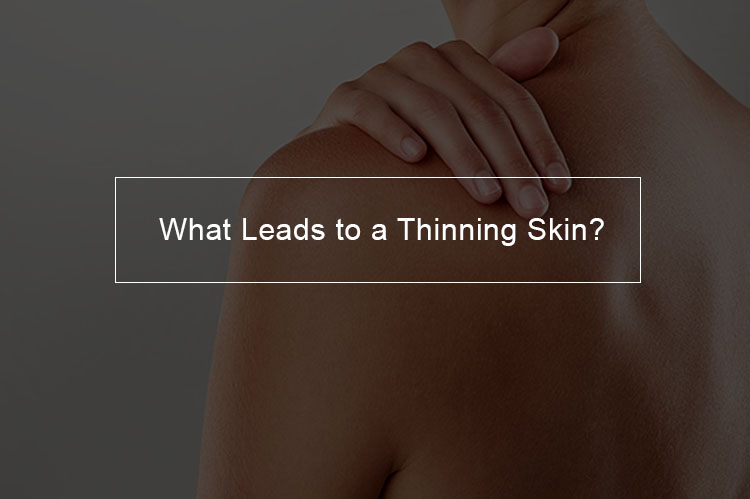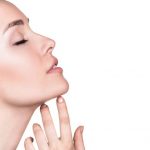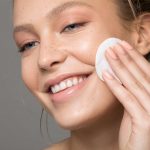
The causes of thin skin are old age, sun damage, and poor lifestyle. Some medications can also play a part in thin skin. There are certain medical complications like thyroid disorders and diabetes that may lead to thin skin. Both elastin and collagen are classes of protein that break down as we get older. A progressive drop in subcutaneous fat within your skin’s hypodermal layer happens as you age, leading to thin skin.
As we get older, the functioning of our cells slows down and this leads to a decrease in skin rejuvenation in comparison to our younger days, therefore, your skin begins thinning. The epidermis comprises a thin outer layer known as the corneal layer. This layer is affected by the sun rays, if you spend less time under the sun you will have a thin corneal layer which offers minimal sun protection allowing sun rays to penetrate deeper into your skin tissues.
Thin Skin on the body; what causes it?
Major Causes of Thin Skin
It’s impossible to stop your skin from aging, the best approach however is maintaining healthy skin through steps like proper hydration keeping your body active through exercise.
Aging Makes the Skin Thinner
With age, our skin gets thinner, we also become more susceptible towards skin blemishes like slow-healing bruises, cuts and age spots. We cannot avoid aging but knowing the relation between skin conditions and thin skin may assist in slowing the impact of time as well as relieving particular skin complications.
Having a thin skin will expose you to the development of lentigines also known as age or liver spots. This skin condition appears like black or brown pigmentation on the face, back, neck and arms that form due to the gradual years spent under the sun. age spots are normally painless and harmless, you should, however, visit a dermatologist to check skin discoloration since the symptoms may resemble those from a type of skin cancer known as melanoma.
The Link Between Thin Skin and Varicose Veins
People with thin skin like the elderly are prone to varicose veins, which is a condition that occurs when valves transporting blood to your heart wear down as a result of inflammation in blood vessels. This leads to blood build up in the veins and they expand and become more conspicuous beneath your skin surface. Varicose veins are not fatal but you may experience pain, visit a dermatologist for proper prescriptions to relieve the pain or undergo treatment to get rid of the veins.
Thin Skin May Lead to Spider Veins
Spider veins are also more prone to people with thin skin, they form when there’s inflammation in blood vessels and are either purple, red-tinged and blue. Spider veins usually form on the face and legs, they can develop in other body parts too.
Sun damage can cause thin skin
A major part of the physical harm to the epidermis such as sagging, wrinkling, thinning skin and liver spots are as a result of the long sun exposure. Damage from ultraviolet rays develops over long gradual years of staying under the sun. You will notice thin skin majorly on these parts of your body like your face, arms and hands, these are the regions that are less covered by clothes. Avoid using tanning mats and beds since they increase the risks of sun exposure.
Constant sun exposure during your childhood days will likely result in thinning skin as you get older. Long exposure to sun rays will increase chances of your skin thinning, it will also make you more prone to other kinds of skin damages so you should wear sunscreen when you spend a long time outside.
Medications that Causes Thin Skin
There are certain individuals that suffer from thinning skin due to using particular medicines for a long period of time:
- OTC aspirin
- Nonsteroidal anti-inflammatory drugs. These types of drugs include naproxen and ibuprofen
- Oral and topical corticosteroids
- Prescription blood thinners
Poor Lifestyle May Cause Thin Skin
3 Everyday Habits That Causes Thin Skin
There are various lifestyle factors that can result in early signs of aging skin. Here are some of these lifestyle habits:
Smoking and Alcohol May Cause Thin Skin
If you’re a heavy drinker or you smoke regularly, you become more susceptible to thinning skin. There are different skin problems and complications that can result from heavy drinking and smoking. For instance, a smoker will develop vertical wrinkles near the mouth known as smoker’s lines that result from puckering lips while smoking. Crow’s feet is another popular kind of wrinkling that forms around the outer ends of the eyes and smokers develop them quicker than non-smokers. You need to consider your use of these two substances if you want to maintain healthy and glowing skin.
Importance of Exercise for Aging Skin
Being active through your day will improve your skin’s elasticity. Exercise will trigger your body to produce adequate collagen and elastin that maintain the youthfulness of your skin. Doing exercise increases blood flow and boosts circulation that delivers more nutrients that provide collagen responsible for a plump, smooth and elastic skin. An increase in circulation will assist in flushing out toxins such as free radicals that trigger early aging signs.
Vitamin Deficiency may Cause Thin Skin
Having plenty of vitamins in your diet is a sure way to encourage your skin to look and feel better than ever before. Choose foods that are rich in vitamin A, E, and K for best results, but don’t neglect the other vitamins your body needs, either. You’re bound to notice a huge change for the better in your skin’s condition when you eat enough vitamin-rich foods. Add in some antioxidants for an even better experience.
How Do I Know If I Have Thin Skin?
What is Thin Skin?
Thin skin is also known as fragile or thinning skin and it’s one that breaks, bruises or tears easily. If a thin skin starts to resemble a tissue paper, it is referred to as crepey skin. Older adults are prone to the thin skin on body parts like hands, arms and face since these parts aren’t covered from the sun for the better part of our lives. If you have thin skin you will be able to see bones, capillaries, tendons, and veins under the skin of your arms. The skin on your arms is made up of multiple layers, the dermis is the middle layer and it makes up 90% of the thickness on your skin. The dermis has fiber tissues that comprise of elastin and collagen. This mid-layer offers elasticity, flexibility, and strength to your skin. You will develop a thin skin when the dermis starts to reduce in thickness. A thin skin may be a result of different factors such as long exposure to sun rays, lifestyle habits, aging, certain medications, and genetics.
Is Having a Thin Skin Bad?
3 Side Effects of a Thin Skin
Thin Skin Leads to Injuries
Having a thin skin will make you more susceptible to injuries and scratches. This is one of the major issues linked with thin skin, it will be the first you notice. If your skin is thin you will easily form bruises, scrapes, and cuts, this may result in more severe and deep wounds.
Sunburn due to Thin Skin
Another ill effect of thin skin is you will be more prone to sunburn. A thin skin equals less defense against issues such as sunburns. If your skin is thin ensure you regularly wear sunscreen when you’re under the sun for a while.
Change in Skin Texture due to Thinness
Thin skin will alter your skin texture, This situation is commonly known as crepey skin and it has a close correlation with a thin skin. When your skin gets too thin it will resemble a light surface and you will feel a rough and rugged surface. This is the aftermath of having thin skin for a long period.
How To Prevent Thinning of Skin?
It’s impossible to reverse a majority of effects of sun rays on your skin.If you have thin skin, you will find yourself easily prone to scrapes, cuts, and bruises. However, there are precautions that can protect you from these risks. There are steps recommended by the American Academy of Dermatology to prevent further skin damage or avoid early skin aging symptoms:
- Remember to protect your skin by wearing sunscreen whenever you step outside. The minimum Sun Protection Factor (SPF) of 30 is recommended.
- Keep away from tanning beds
- Stick to a well-balanced meal plan with plenty of vitamins
- Minimize or stop alcohol intake since it’ll dehydrate your body.
- Quit smoking for a healthy skin
- Stay active or exercise regularly to improve the function of your immune system to feel and look young.
- Softly and regularly was your skin after activities that cause sweating
- Spread a moisturizer every day to keep your skin moisture locked for a healthy look
- Stop using products on your skin that have a burning irritation or ones that cause an allergic reaction, visit a dermatologist for the best prescriptions.
Office-Based Treatment For Thin Skin
Here are some of the office-based treatments; intense pulsed light and photodynamic therapy, injectable skin, and dermal fillers, micro needling and laser resurfacing.
Intense Pulsed Light (IPL) and Photodynamic therapy (PDT) Revive Skin
Intense Pulsed Light remedy is popularly known as a photo facial, it’s a light-oriented skin revival remedy. It mechanism focuses on a particular wavelength of light onto your skin surface. Photodynamic therapy is a more thorough light-oriented remedy, the physician first covers spread a topical photosensitive cream on your skin. You need to visit the dermatologist a number of times for you to achieve maximum results from both of the treatments. Both remedies trigger collagen production which assists in reducing the noticeable damage from UV rays. The two treatments can be safely used on your hands, chest, neck, and face.
Injectable skin and dermal fillers
You can find different skin and dermal fillers that will replenish volume loss in your skin, making it plump and give you a youthful look. They’re majorly used on the face but the fillers are also effective for restoring hand skin. You may find fillers that offer immediate results that last for two years while others need multiple doctor visits to achieve noticeable results within 2 or 3 months. Visit a dermatologist to get the best filler prescription for your skin.
Microneedling To Revive Your Skin
You can do derma rolling/micro needling to revive your skin either in a doctor’s office or at home. The derma roller that physicians use have longer needles than the ones you can buy for DIY use. These type can be useful if your aim is noticeable skin changes. This can be helpful for people who are looking for significant skin changes. The doctor will first cover your skin with a topical anesthetic then roll a hand tool roller fixed with small needles over your skin surface. These tiny needles cause minimal pinpoint bleeding but won’t destroy your skin. You need multiple visits which will result in a boost in collagen production that improves suppleness and elasticity of your skin.
Laser resurfacing treatments Reduces Visible Sun Rays Effects
There are multiple office-based laser treatments that are accessible to assist in reducing the noticeable aging signs that come from long exposure to sun rays. Lasers like ablative lasers produce effective outcomes through vaporizing the tissue, another benefit of this treatment is a short recovery period. If a doctor uses a non-ablative laser procedure the outcome will be moderate with minimal downtime. Visit a professional like a dermatologist to pick the best procedure for your skin condition.




